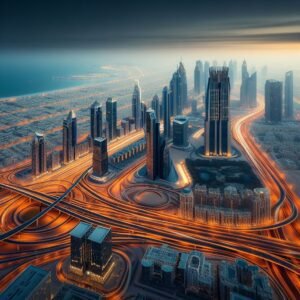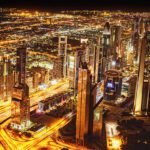Dubai, known for its towering skyscrapers, luxury shopping, and vibrant nightlife, is also renowned for its perpetually warm nights. Even after the sun sets, the temperature remains high, creating a unique experience for residents and visitors alike. In this article, we’ll delve into the factors behind Dubai’s hot nights and explore the implications for daily life and the environment.
Understanding Dubai’s Climate
Dubai, situated on the southeastern coast of the Persian Gulf, experiences a desert climate characterized by scorching temperatures and minimal rainfall. The city’s geographical location near the Tropic of Cancer contributes to its extreme weather conditions, with summer temperatures often exceeding 40°C (104°F). Despite the arid climate, Dubai’s nights are notably warmer than in other desert regions, leading to a phenomenon known as the urban heat island effect.
Factors Contributing to Warm Nights in Dubai
Urban Heat Island Effect
The urban heat island effect is when urban areas experience higher temperatures than their rural surroundings due to human activities and infrastructure. In Dubai, rapid urbanization and extensive construction have exacerbated this effect, leading to elevated nighttime temperatures.

Building Materials and Architecture
Dubai’s skyline is dominated by towering skyscrapers and modern architectural marvels constructed using materials that absorb and retain heat. Glass facades, concrete structures, and steel frameworks contribute to the city’s urban heat island effect by trapping heat during the day and releasing it slowly at night.
Artificial Lighting and Energy Consumption
The extensive use of artificial lighting and energy-intensive activities in Dubai further exacerbate the urban heat island effect. The city’s vibrant nightlife, illuminated landmarks, and bustling commercial districts result in heightened energy consumption, leading to increased heat emissions and elevated nighttime temperatures.
Lack of Natural Cooling
Unlike traditional desert landscapes, which experience significant temperature fluctuations between day and night, Dubai’s urban environment lacks natural cooling mechanisms such as vegetation and open spaces. The city’s limited greenery and expansive built-up areas contribute to the retention of heat, particularly during the night when temperatures should naturally decrease.
Effects on Daily Life and Environment
Dubai’s hot nights have profound effects on both human well-being and the surrounding environment, influencing various aspects of daily life and ecosystem dynamics.
Impact on Energy Consumption
The persistence of warm nights in Dubai necessitates continuous air conditioning usage to maintain comfortable indoor temperatures, resulting in increased energy consumption and higher utility bills for residents and businesses. The heightened demand for cooling during nighttime hours strains the city’s energy infrastructure and contributes to peak electricity loads, leading to potential power shortages and grid instability.
Effects on Health and Well-being
Prolonged exposure to high temperatures during the night can have detrimental effects on human health and well-being, increasing the risk of heat-related illnesses such as heat exhaustion, heatstroke, and dehydration. Vulnerable populations, including the elderly, children, and individuals with pre-existing health conditions, are particularly susceptible to the adverse effects of warm nights in Dubai. Additionally, poor air quality exacerbated by stagnant atmospheric conditions during nighttime hours can exacerbate respiratory issues and cardiovascular diseases.
Environmental Consequences
Dubai’s urban heat island effect not only impacts human inhabitants but also has significant environmental consequences, affecting local flora, fauna, and ecosystem dynamics. The lack of natural cooling mechanisms and the proliferation of heat-absorbing surfaces disrupt the ecological balance, leading to habitat degradation, reduced biodiversity, and altered microclimatic conditions. Additionally, increased temperatures and reduced moisture levels can exacerbate desertification and soil degradation, posing long-term challenges for sustainable land management and conservation efforts.
Mitigation Strategies
Addressing the challenges posed by Dubai’s hot nights requires proactive measures aimed at mitigating the urban heat island effect and promoting sustainable urban development practices.
Urban Planning and Design Solutions
Incorporating sustainable urban planning and design principles into future developments can help mitigate the urban heat island effect and reduce nighttime temperatures in Dubai. Strategies such as increasing green spaces, implementing cool roof technologies, and promoting mixed land use patterns can enhance thermal comfort, mitigate heat island effects, and improve urban livability.
Green Initiatives
Investing in green infrastructure projects, such as parks, urban forests, and green roofs, can enhance natural cooling mechanisms and mitigate the adverse effects of warm nights in Dubai. By increasing vegetation cover and promoting biodiversity, green initiatives reduce urban heat island effects, improve air quality, mitigate stormwater runoff, and enhance urban aesthetics.
Public Awareness and Education
Raising public awareness about the importance of energy conservation and sustainable lifestyle choices is crucial for addressing the challenges of warm nights in Dubai. Educating residents, businesses, and policymakers about the environmental, social, and economic benefits of mitigating the urban heat island effect can foster community engagement, drive behavioral change, and catalyze the adoption of sustainable practices at the individual and institutional levels.
Conclusion
Dubai’s hot nights, fueled by the urban heat island effect and exacerbated by human activities, pose significant challenges to urban sustainability, human well-being, and environmental resilience. By implementing proactive mitigation strategies, such as sustainable urban planning, green infrastructure development, and public awareness initiatives, Dubai can mitigate the adverse effects of warm nights, enhance urban livability, and promote a more sustainable and resilient future for its residents and ecosystems.











Hi, its pleasant post regarding media print, we all know media
is a impressive source of information.